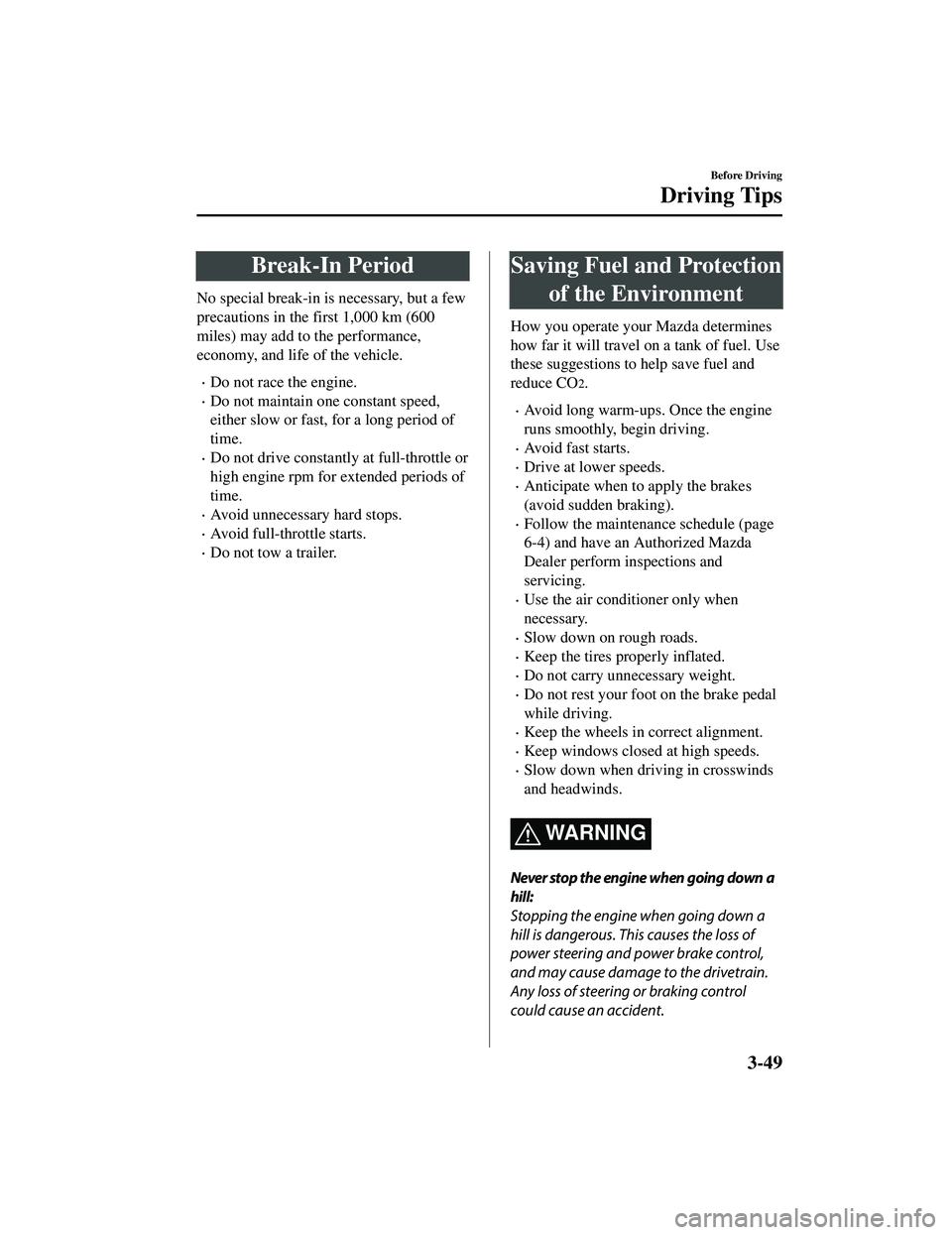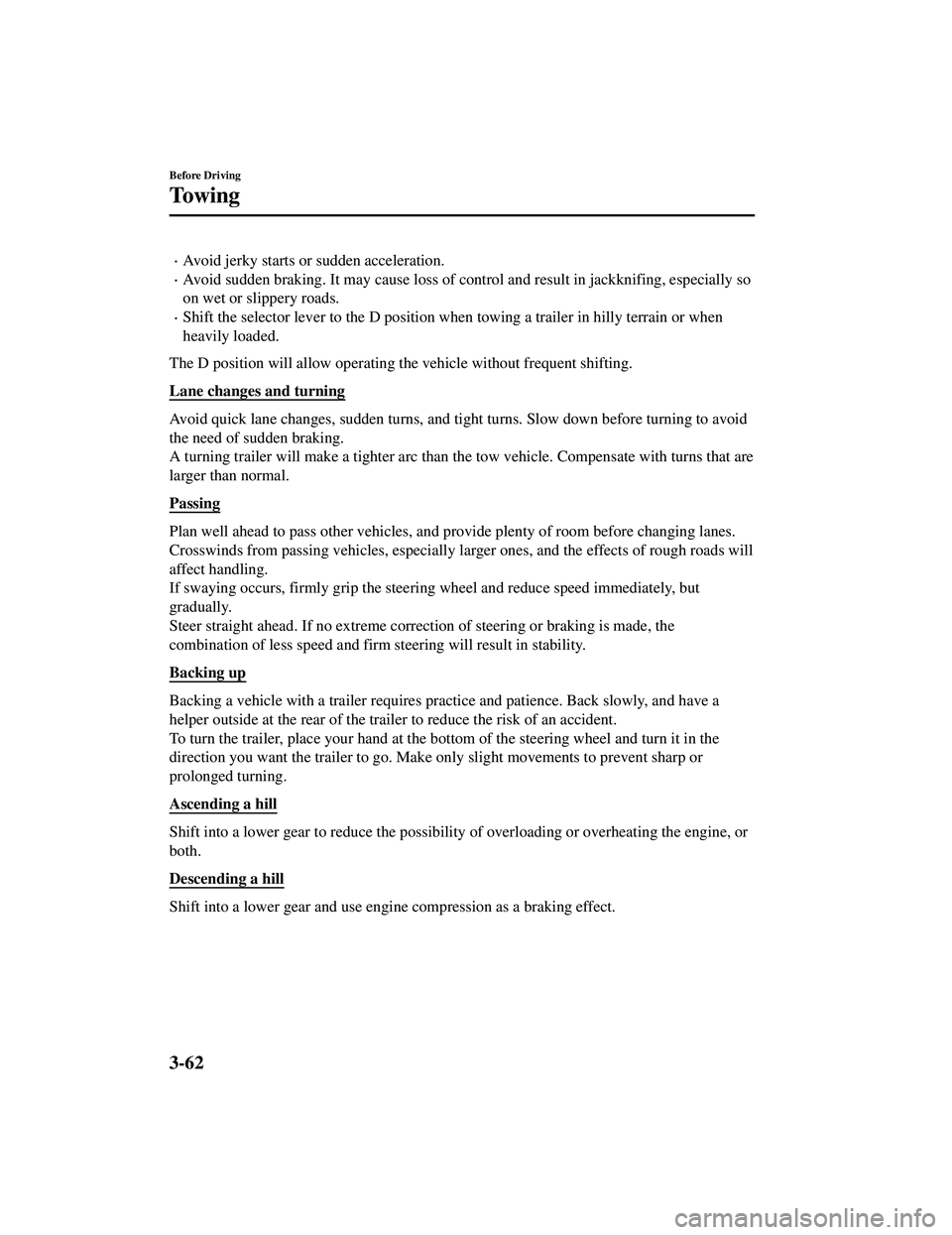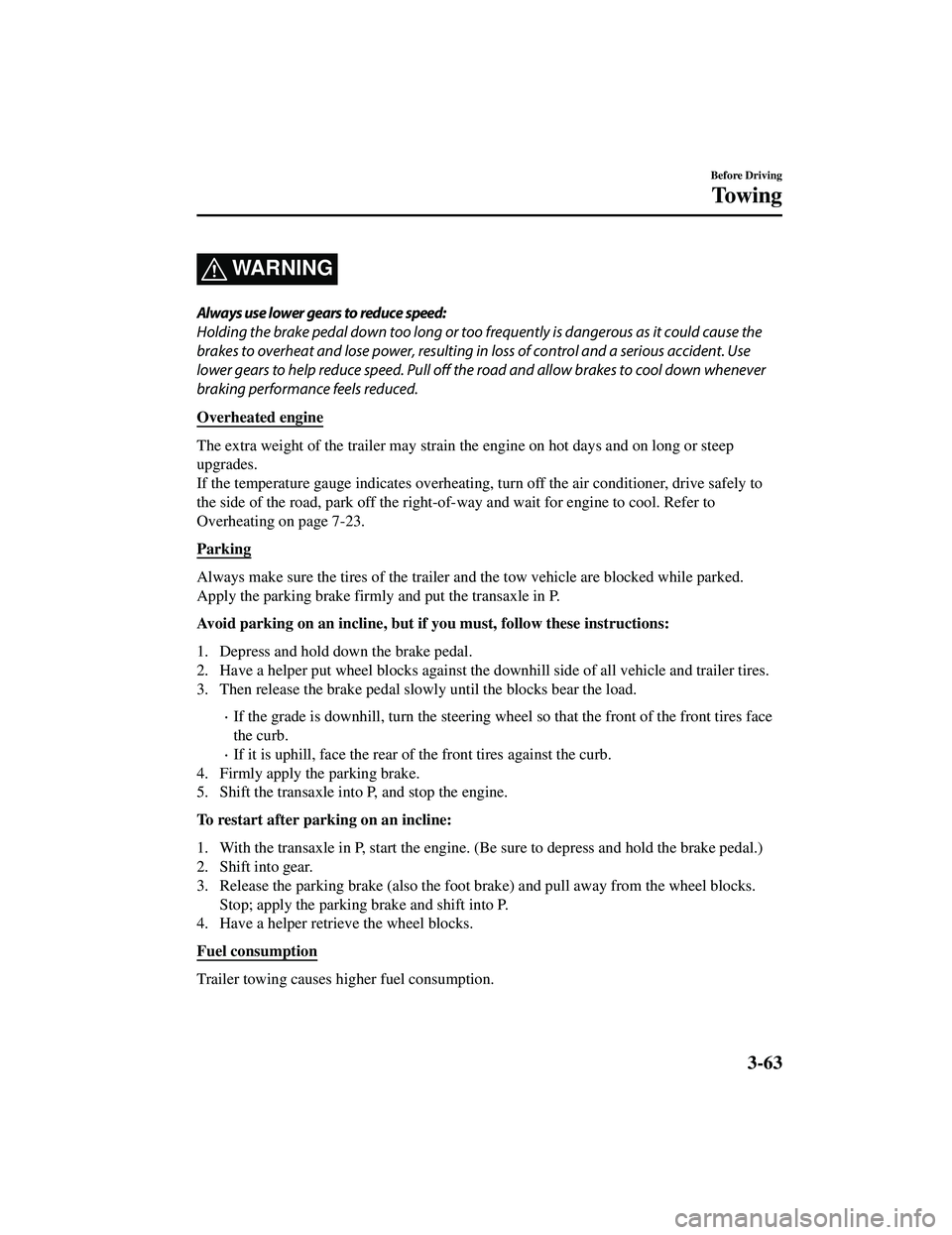steering MAZDA MODEL CX-9 2021 User Guide
[x] Cancel search | Manufacturer: MAZDA, Model Year: 2021, Model line: MODEL CX-9, Model: MAZDA MODEL CX-9 2021Pages: 723, PDF Size: 10.61 MB
Page 47 of 723

Heated Steering Wheel*
The grips on the left and right of the
steering wheel can be warmed up.
Heating areaHeated steering
wheel switch
The ignition must be switched ON.
Press the switch to
turn on the heated
steering wheel. The heated steering wheel
operates for about 30 minutes and then
turns off automatically.
The indicator light illuminates when the
heater is operating.
To turn off the heated steering wheel
before the 30 minutes has elapsed, press
the switch again.
CAUTION
The following types of persons should be
careful not to touch the steering wheel.
Otherwise, it could cause a
low-temperature burn.
Infants, small children, elderly people,
and physically challenged people
People with delicate skin
People who are excessively fatigued
People who are intoxicated
People who have taken sleep-inducing
medicine such as sleeping pills or cold
medicine
Essential Safety Equipment
Seat Warmer/Seat Ventilatio n/Heated Steering Wheel
2-34*Some models.
CX-9_8JK1-EA-20G_Edition6_old 2021-12-8 9:30:44
Page 82 of 723

Supplemental Restraint System (SRS) Precautions
The front and side supplemental restraint system s (SRS) include different types of air bags.
Please verify the different types of air b ags which are equipped on your vehicle by
locating the “SRS AIRBAG” location indicators. These indicators are visible in the area
where the air bags are installed.
The air bags are installed in the following locations:
The steering wheel hub (driver air bag)
The front passenger dashboard (front passenger air bag)
The outboard sides of the front seatbacks (side air bags)
The front and rear window pillars, and the roof edge along both sides (curtain air bags)
Vehicles with the Front Passenger Occupant Classification System have a sensor which
detects an impending roll-over accident.
The air bag supplemental restraint systems are designed to provide supplemental protection
in certain situations so seat belts are always important in the following ways:
Without seat belt usage, the air bags cannot provide adequate protection during an accident.
Seat belt usage is necessary to:
Keep the occupant from being th rown into an inflating air bag.
Reduce the possibility of injuries during an accident that is not designed for air bag
inflation, such as rear impact.
Reduce the possibility of injuries in frontal, near frontal or side collisions or roll-over
accidents that are not severe enough to activate the air bags.
Reduce the possibility of being thrown from your vehicle.
Reduce the possibility of injuries to lower body and legs during an accident because the
air bags provide no protection to these parts of the body.
Essential Safety Equipment
SRS Air Bags
2-69
CX-9_8JK1-EA-20G_Edition6_old 2021-12-8 9:30:44
Page 84 of 723

WARNING
Seat belts must be worn in air bag equipped vehicles:
Depending only on the air bags for protection during an accident is dangerous. Alone, air
bags may not prevent serious injuries. The appropriate air bags can be expected to inflate
only in the first accident, such as frontal, near frontal or side collisions or roll-over accidents
that are at least moderate. Vehicle occu pants should always wear seat belts.
Children should not ride in the front passenger seat:
Placing a child, 12 years or under, in the front seat is dangerous. The child could be hit by a
deploying air bag and be seriously injured or ev en killed. A sleeping child is more likely to lean
against the door and be hit by the side air ba g in moderate collision to the front-passenger
side of the vehicle. Whenever possible, always secure a child 12 years and under on the rear
seats with an appropriate child-restraint system for the child's age and size.
Never use a rear-facing child-restraint system in the front seat with an air bag that could
deploy:
Rear-facing child-restraint systems on the front seat are particularly dangerous even though
you may feel assured that a front passenger air bag will not deploy based on the fact that the
front passenger air bag deactivation indicato r light illuminates. The child-restraint system
can be hit by a deploying air bag and moved viol ently backward resulting in serious injury or
death to the child.
Do not sit too close to the driver and front passenger air bags:
Sitting too close to the driver and front passenger air bag modules or placing hands or feet on
them is extremely dangerous. The driver and front passenger air bags inflate with great force
and speed. Serious injuries could occur if someon e is too close. The driver should always hold
onto only the rim of the steering wheel. The front seat passenger should keep both feet on the
floor. Front seat occupants should adjust their seats as far back as possible and always sit
upright against the seatbacks with seat belts worn properly.
Essential Safety Equipment
SRS Air Bags
2-71
CX-9_8JK1-EA-20G_Edition6_old 2021-12-8 9:30:44
Page 87 of 723

Do not modify a front door or leave any damage unrepaired. Always have an Authorized
Mazda Dealer inspect a damaged front door:
Modifying a front door or leaving any damage unrepaired is dangerous. Each front door has a
side crash sensor as a component of the suppleme ntal restraint system. If holes are drilled in a
front door, a door speaker is left removed, or a damaged door is left unrepaired, the sensor
could be adversely affected causing it to not de tect the pressure of an impact correctly during
a side collision. If a sensor does not detect a side impact correctly, the side and curtain air
bags and the front seat belt pretensioner may not operate normally which could result in
serious injury to occupants.
Do not modify the supplemental restraint system:
Modifying the components or wiring of the su pplemental restraint system is dangerous. You
could accidentally activate it or make it inoperable. Do not make any modifications to the
supplemental restraint system. This includes inst alling trim, badges, or anything else over the
air bag modules. It also includes installing extra electrical equipment on or near system
components or wiring. An Authorized Mazda Dealer can provide the special care needed in
the removal and installation of front seats. It is important to protect the air bag wiring and
connections to assure that the bags do not ac cidentally deploy, and that the front passenger
occupant classification system and the seats retain an undamaged air bag connection.
Do not place luggage or other objects under the front seats:
Placing luggage or other objects under th e front seats is dangerous. The components
essential to the supplemental restraint system could be damaged, and in the event of a side
collision, the appropriate air bags may not de ploy, which could result in death or serious
injury. To prevent damage to the components e ssential to the supplemental restraint system,
do not place luggage or other objects under the front seats.
Do not operate a vehicle with damaged air bag/seat belt pretensioner system components:
Expended or damaged air bag/seat belt pret ensioner system components must be replaced
after any collision which caused them to depl oy or damage them. Only a trained Authorized
Mazda Dealer can fully evaluate these systems to see that they will work in any subsequent
accident. Driving with an expended or damaged air bag or pretensioner unit will not afford
you the necessary protection in the event of any subsequent accident which could result in
serious injury or death.
Do not remove interior air bag parts:
Removing any components such as the front se ats, front dashboard, the steering wheel or
parts on the front and rear window pillars and along the roof edge, containing air bag parts
or sensors is dangerous. These parts contain essential air bag components. The air bag could
accidentally activate and cause serious injuri es. Always have an Authorized Mazda Dealer
remove these parts.
Essential Safety Equipment
SRS Air Bags
2-74
CX-9_8JK1-EA-20G_Edition6_old 2021-12-8 9:30:44
Page 91 of 723

How the SRS Air Bags Work
Your Mazda is equipped with the following types of SRS air bags. SRS air bags are
designed to work together with the seat belts to help to reduce injuries during an accident.
The SRS air bags are designed to provide further protection for passengers in addition to the
seat belt functions. Be sure to wear seat belts properly.
▼ Front Seat Belt Pretensioners
The front seat belt pretensioners are designed
to deploy in moderate or severe frontal, near
frontal collisions.
In addition, the pretensioners operate when a side collision or a roll-over accident is
detected. The pretensioners operate differen tly depending on what types of air bags are
equipped. For more details about seat belt pretensioner operation, refer to the SRS Air Bag
Deployment Criteria (page 2-82).
▼ Driver Air Bag
The driver's air bag is mounted in the steering wheel.
When air bag crash sensors detect a frontal im
pact of greater than moderate force, the
driver's air bag inflates quickly helping to reduce injury mainly to the driver's head or chest
caused by directly hitting the steering wheel.
For more details about air bag deployment, refer to "SRS Air Bag Deployment Criteria"
(page 2-82).
(With Front Passenger Occupa nt Classification System)
The driver's dual-stage air bag controls ai r bag inflation in two energy stages. During an
impact of moderate severity, the driver's air bag deploys with lesser energy, whereas during
more severe impacts, it deploys with more energy.
▼ Front Passenger Air Bag
The front passenger air bag is mounted in the front passenger dashboard.
The inflation mechanism for the front passenger air bag is the same as the driver's air bag.
Essential Safety Equipment
SRS Air Bags
2-78
CX-9_8JK1-EA-20G_Edition6_old
2021-12-8 9:30:44
Page 152 of 723

Break-In Period
No special break-in is necessary, but a few
precautions in the first 1,000 km (600
miles) may add to the performance,
economy, and life of the vehicle.
Do not race the engine.
Do not maintain one constant speed,
either slow or fast, for a long period of
time.
Do not drive constantly at full-throttle or
high engine rpm for extended periods of
time.
Avoid unnecessary hard stops.
Avoid full-throttle starts.
Do not tow a trailer.
Saving Fuel and Protectionof the Environment
How you operate your Mazda determines
how far it will travel on a tank of fuel. Use
these suggestions to help save fuel and
reduce CO
2.
Avoid long warm-ups. Once the engine
runs smoothly, begin driving.
Avoid fast starts.
Drive at lower speeds.
Anticipate when to apply the brakes
(avoid sudden braking).
Follow the maintenance schedule (page
6-4) and have an Authorized Mazda
Dealer perform inspections and
servicing.
Use the air conditioner only when
necessary.
Slow down on rough roads.
Keep the tires properly inflated.
Do not carry unnecessary weight.
Do not rest your foot on the brake pedal
while driving.
Keep the wheels in correct alignment.
Keep windows closed at high speeds.
Slow down when driving in crosswinds
and headwinds.
WA R N I N G
Never stop the engine when going down a
hill:
Stopping the engine when going down a
hill is dangerous. This causes the loss of
power steering and power brake control,
and may cause damage to the drivetrain.
Any loss of steering or braking control
could cause an accident.
Before Driving
Driving Tips
3-49
CX-9_8JK1-EA-20G_Edition6_old 2021-12-8 9:30:44
Page 165 of 723

Avoid jerky starts or sudden acceleration.
Avoid sudden braking. It may cause loss of control and result in jackknifing, especially so
on wet or slippery roads.
Shift the selector lever to the D position wh en towing a trailer in hilly terrain or when
heavily loaded.
The D position will allow operating th e vehicle without frequent shifting.
Lane changes and turning
Avoid quick lane changes, sudden turns, and tight turns. Slow down before turning to avoid
the need of sudden braking.
A turning trailer will make a tighter arc than th e tow vehicle. Compensate with turns that are
larger than normal.
Passing
Plan well ahead to pass other vehicles, and provide plenty of room before changing lanes.
Crosswinds from passing vehicles, especially larger ones, and the effects of rough roads will
affect handling.
If swaying occurs, firmly grip the steering wheel and reduce speed immediately, but
gradually.
Steer straight ahead. If no extreme correc tion of steering or braking is made, the
combination of less speed and firm steering will result in stability.
Backing up
Backing a vehicle with a trailer requires practice and patience. Back slowly, and have a
helper outside at the rear of the trailer to reduce the risk of an accident.
To turn the trailer, place your hand at the bott om of the steering wheel and turn it in the
direction you want the trailer to go. Make only slight movements to prevent sharp or
prolonged turning.
Ascending a hill
Shift into a lower gear to redu ce the possibility of overloading or overheating the engine, or
both.
Descending a hill
Shift into a lower gear and use engine compression as a braking effect.
Before Driving
To w i n g
3-62
CX-9_8JK1-EA-20G_Edition6_old 2021-12-8 9:30:44
Page 166 of 723

WARNING
Always use lower gears to reduce speed:
Holding the brake pedal down too long or too frequently is dangerous as it could cause the
brakes to overheat and lose power, resulting in loss of control and a serious accident. Use
lower gears to help reduce speed . Pull off the road and allow brakes to cool down whenever
braking performance feels reduced.
Overheated engine
The extra weight of the trailer may strain the engine on hot days and on long or steep
upgrades.
If the temperature gauge indicates overheating, turn off the air conditioner, drive safely to
the side of the road, park off the right-of- way and wait for engine to cool. Refer to
Overheating on page 7-23.
Parking
Always make sure the tires of the trailer and the tow vehicle are blocked while parked.
Apply the parking brake firmly and put the transaxle in P.
Avoid parking on an incline, but if you must, follow these instructions:
1. Depress and hold down the brake pedal.
2. Have a helper put wheel blocks against the downhill side of all vehicle and trailer tires.
3. Then release the brake pedal slowly until the blocks bear the load.
If the grade is downhill, turn the steering wheel so that the front of the front tires face
the curb.
If it is uphill, face the rear of the front tires against the curb.
4. Firmly apply the parking brake.
5. Shift the transaxle into P, and stop the engine.
To restart after parking on an incline:
1. With the transaxle in P, start the engine. (Be sure to depress and hold the brake pedal.)
2. Shift into gear.
3. Release the parking brake (also the foot brake) and pull away from the wheel blocks. Stop; apply the parking brake and shift into P.
4. Have a helper retrieve the wheel blocks.
Fuel consumption
Trailer towing causes higher fuel consumption.
Before Driving
To w i n g
3-63
CX-9_8JK1-EA-20G_Edition6_old 2021-12-8 9:30:44
Page 170 of 723

4When Driving
Information concerning safe driving and stopping.
Start/Stop Engine.............................. 4-4 Ignition Switch........ ..................... 4-4
Starting the Engine....................... 4-5
Turning the Engine Off...............4-10
Instrument Cluster and Display ............
........................................................... 4-11 Instrument Cluster and
Display........................................ 4-11
Instrument Cluster (Type A)....... 4-12
Instrument Cluster (Type B)....... 4-29
Instrument Cluster (Type C)....... 4-44
Active Driving Display
*............. 4-56
Automatic Transaxle....................... 4-59 Automatic Transaxle
Controls...................................... 4-59
Shift-Lock System...................... 4-60
Transaxle Ranges........................4-60
Manual Shift Mode..................... 4-62
Direct Mode
*.............................. 4-68
Driving Tips................................4-69
Switches and Controls..................... 4-70 Lighting Control......................... 4-70
Fog Lights
*................................. 4-76
Turn and Lane-Change
Signals........................................ 4-77
Windshield Wipers and
Washer........................................ 4-78
Rear Window Wiper and
Washer........................................ 4-81
Rear Window Defogg er.............. 4-82
Horn............................................ 4-83
Hazard Warning Flasher............. 4-84
HomeLink Wireless Control System
(Type A)
*.................................... 4-84
HomeLink Wireless Control System
(Type B)
*.................................... 4-88
Brake................................................ 4-92 Brake System.............................. 4-92
AUTOHOLD.............................. 4-96
Hill Launch Assist (HLA)........ 4-100
ABS/TCS/DSC/Trailer Stability
Control (TSC)/Off-Road Traction
Assist............................................... 4-102 Antilock Brake System
(ABS)........................................4-102
Traction Control System
(TCS)........................................ 4-103
Dynamic Stability Control
(DSC)........................................4-105
Trailer Stability Control
(TSC)........................................ 4-106
Off-Road Traction Assist
*........ 4-107
Drive Selection............................... 4-109 Drive Selection......................... 4-109
i-ACTIV AWD................................4-111 i-ACTIV AWD Operation
*....... 4-111
Power Steering............................... 4-113 Power Steering..........................4-113
*Some models.4-1
CX-9_8JK1-EA-20G_Edition6_old 2021-12-8 9:30:44
Page 192 of 723

▼Warning/Indicator Lights
Instrument Cluster varies depending on model and specifications.
Center of Dashboard
Warning lights will appear in any of the highlighted areas
Instrument Cluster
▼
Warning Indication/Warning Lights
These lights turn on or flash to notify the us
er of the system operation status or a system
malfunction.
Signal Warning Page
Brake System Warning Indication/Warning Light*1*27-28
ABS Warning Light*1
Electronic Brake
Force Distribu ‐
tion System Wa r n i n g 7-28
ABS warning 7-31
Charging System Warning Indication/Warning Light*17-28
Engine Oil Warning Light*17-28
High Engine Coolant Temperature Warning Indication 7-28
Power Steering Malfunction Indication7-28
Master Warning Indication 7-31
When Driving
Instrument Cluster and Display
4-23
CX-9_8JK1-EA-20G_Edition6_old 2021-12-8 9:30:44